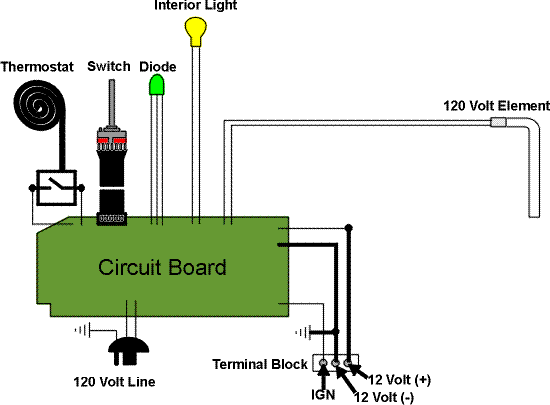Dave's Place
AES AC Operation (first generation)
Before working with electricity, visit the electrical safety page.

AC (120 volt) is the first choice of the circuit board for heating the cooling unit. The 120 volt input goes directly to the circuit board (passing through a junction block). If the circuit board senses 120 volt and the thermostat is calling for cooling, the circuit board sends 120 volt to the electric heat element via a relay built onto the circuit board.
Troubleshooting AC Operation
Situation One:
You're RV is plugged into 120 volt, the refrigerator is on, the thermostat is turned up, the
appropriate indicator light(s) are on, and everything appears to be normal, but the refrigerator is not
cooling. First, check to see if the heat element is getting hot. Touch the insulation pack (a round,
tall sheet metal container filled with insulation located directly above the propane burner at the
back of the refrigerator) to see if it is warm after about a half hour of operation. CAUTION: touch
the pack lightly at first; it is possible under certain conditions for the pack to get super hot
and burn you. If the insulation pack is warm, the heat element is working
and you may have a cooling unit problem. If the insulation pack
is not warm, you need to find out why.
At this point, the problem could be in the AC circuitry, the thermostat, or switch mechanism. A quick test for the thermostat and switch would be to unplug the AC cord and see if the refrigerator tries to light on propane. If it does, the thermostat and switch are all right. If it doesn't, check out the electric thermostat and switch page. If these two components are good, check out the circuit board for possible problems.
After determining that the thermostat and switch are good, the next step is to see if the problem lies in the heat element itself, or in the lack of voltage to the element. The heat element on the RM1303 vintage models connects to a plug wired from the circuit board. Later models have the element connected directly to the circuit board. Locate this connection and disconnect it if necessary to check it for 120 volt to the element. Since you're working with live voltage, be careful not to harm yourself or the equipment. Disconnect the power if necessary, until you're in a safe position to test. If power is present at this point and the element didn't get hot, the heat element is bad. If voltage is not present the circuit board (or connections between the circuit board and heat element ) is bad. We already know there is 120 volt to the circuit board, since when we unplugged the refrigerator earlier, it tried to light on gas. If it is determined that the circuit board is bad, the heat element may have been the cause. See the circuit board page for more details.
Situation Two:
You're RV is plugged into 120 volt, the refrigerator is on, the thermostat is turned up, the appropriate
indicator light(s) are on, and everything appears to be normal, but the refrigerator refuses to operate
on 120 volt and always lights on propane instead. Assuming you have good 12 volt supply to power the
circuit board, the problem is relatively simple. Either 120 volt is not getting to the circuit board,
or the circuit board is bad. Trace 120 volt from the receptacle the refrigerator is plugged into
through to the connections on the circuit board. If 120 volt is present at the circuit board and the
refrigerator continues to light on gas, the circuit board is bad. A burned out 120 volt heat element
would not cause the problem, since the circuit board would not "know" the element is burned out.
Although the element wouldn't be the immediate cause of this problem, it is possible that the element
damaged the circuit board in such a way as to create the problem. See the
circuit board page for more details.
Dometic AES System
RV Refrigerator Home
This RV refridgerator information was originally located on rvmobile.comRV Mobile Inc. 11715 HWY 99, Everett, WA 98204
The owner of RV Mobile Inc. apparently suffered a heart attack and the original website was shut down.
It has been reposted here to preserve this wealth of information RV refridgerator information.